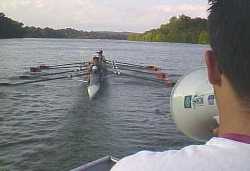Eight Men Out, One Awesome Ride
Ryan Cirz, Derek Lustig, Robert Honstein, Greg Skover, Dave Hangman, Brian Green, Rich Fitzgerald, name withheld and Andie Sesko
It is a beautiful Sunday evening on Lake Carnegie, one of the finest rowing courses in the eastern U.S., donated to Princeton university by Andrew Carnegie nearly a century ago. When the Princeton crew isn't churning around this three-mile lake, the United States national and Olympic men's and women's teams practice here, as does this league, with over 300 members.
The first rowing club in the United States was the Detroit Boat Club, started in 1839. The first inter-collegiate sport in our country was rowing, started when Yale and Harvard stroked it out on Lake Winnepesaukee in 1852. During the next century, rowing was very popular and professional rowers were some of the most widely followed of all athletes, according to the Oxford Companion to World Sports and Games.
Rowing crew is exactly like using a rowing machine - it's that simple. You just plop your large butt in the small seat, strap your feet in, grab the handle and pull and push and pull and push...
If, however, you actually want the boat to move, then you've got to lower the oar blade into the water and keep it there while you pull, then raise it out while you push. Getting it? Good.
Now, if you would like to stay in the boat, you've got to keep your balance (the boat could be narrower than your shoulders.) If you would like to stay in the race, you've got to keep your timing and if you want to stay on the team, you've got to keep your concentration, focus, strength and stamina.
And if you want to win the race, you have to do all this perfectly, nearly two-hundred times in succession, exactly like your seven crewmates and better than the guys in the next boat.
"It's the ultimate team sport," says Gary Mount, a fifties-something apple grower and community team member. "You can be the most fantastic athlete, but in a boat of eight people, you might not add much to the team. It's a frustration for some people, but a good thing also. They have to back off of what makes them an individual."
Rowing is unique in that, for the individual, there is no interaction with teammates, little strategy and only two things to do; row and row harder. But it is a very complex sport, combining strength with consistency.
Take the stroke, for example. There is only one stroke and it is your only tool. You will use it again and again and again. Work the stroke, study the stroke, live the stroke. Eat the stroke for breakfast, lunch and dinner. Digest it, then break it down into four movements and study them.
The first part of the stroke is the Catch. Here is where you "catch" the water with your oar blade far behind you. It is more than just putting the oar in the water, it is like cutting diamonds.
Now for the business. Begin your Drive with your blade far behind you, your arms straight forward and your knees bent, and PULL! Straighten your knees and bend your arms. This is where you drive the boat. Slack here and you swim home.
Come out of your drive with the Finish, lifting your blade out of the water and turning the oar to "feather" or slice through the air during the next step, the Recovery. If you miss the Finish, you'll "Catch the Crab" as your blade continues underwater and your oar handle grabs you by the chest and tosses you from the boat.
Got it? Good. Now do it again.
If you are not working your stroke perfectly, don't worry. A little voice will tell you what to do. That voice comes from a small loudspeaker in the bow, connected to a microphone in the stern, on the head of the coxswain, a team member selected for his or her small mass and large ego.
Julie Peterson leads her crew of rowers (L-R);
It is the role of the coxswain (pronounced "cox-in" or whatever you're in the mood for) to captain the boat, steer the boat, direct the team and to bully each member into behaving exactly like the others - that is, perfectly. This evening Andie Sesko and Julie Peterson, two young ladies, barely old enough to drink, are barking orders at men who are two, even three times their age, men who have raised families, accomplished major feats, led large corporations, fought wars...
"It's actually good that people are telling you what to do," says Mike Naghton, an engineer who has been rowing since 1991. "It allows you to focus on your stroke." Naghton, like all rowers, is in search of the Perfect Stroke, and his reward is simple; "The faster the boat moves, the better it feels."
It feels pretty good for these men who range in age from late teens to early sixties. It felt pretty good for rowers on the women's teams today, and even for the beginner rowers. All adult age groups and levels of ability are accommodated here.
The first man facing the coxswain is the Stroke. He leads the crew with his timing. It is a myth that the coxswain chants "stroke, stroke," because each man gets his timing from the man in front of him. The next few rowers are there strictly for power, while the men in the bow must keep the whole thing steady and true.
Rowing is mostly practice and little actual competition, especially for recreational teams. This team will compete in only five, 2,000 meter regattas this year, each lasting only six minutes or so, and one "To the Head" race of twenty minutes. There are no trophies for winning, only the reward of the achievement, and when you are pushing nearly a ton of gear and people along at fifteen miles an hour, you've got your achievement.
Thanks to the cooperation of Princeton University, people in this area are able to enjoy rowing. Dues are $125 per season (April to November) and there is a five dollar "seat fee" each time you row. Not bad, considering a new, eight-person boat, fifty-five to sixty feet long, would cost you over $20,000.
The university is glad to have the recreational rowers, now in their twelfth season. "It's really opened the door to the community," says Curtis Jordan, Princeton Crew Coach of twenty years. "We have always strived to have interests within the community and so this team has really been a great addition to the University."
After two hours of this, Larrow has had enough. "OK, good work, he says. "To the dock."
Like to join a crew? It's a great workout, a great rush, and a great equalizer. It's also a nice day out on the lake.
contact a college or University near you or try this web site: Rowers Resource
Return to our MAIN page
|



 Larrow, from the launch, continues his coaching; "We must get the port hands up - it's very simple... Lay those roll-outs, we don't want any sails... No lurching or lunging of the bodies - even over the knee."
Larrow, from the launch, continues his coaching; "We must get the port hands up - it's very simple... Lay those roll-outs, we don't want any sails... No lurching or lunging of the bodies - even over the knee."
